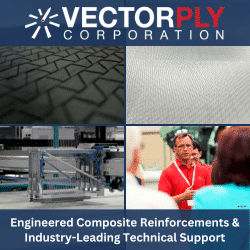

An Eye-Catching Penthouse Roof
Modeled on the angular wings of an F-117 Nighthawk fighter jet, a roof made from composite sandwich panels soars atop a lounge and deck above the penthouse of a Sydney, Australia, apartment. Part roof, part sculpture, the structure, which was designed by Australian architect Richard Goodwin, isn’t merely eye-catching. It also reduces the building’s carbon footprint by channeling rainwater into ground level tanks.
The roof features 1200 g quadriaxial E-glass/KINETIX epoxy skins with a 60 mm end grain balsa core (150 kg/m3) fabricated by ATL Composites of Queensland, Australia.
“The fabrication involved an internal steel skeleton, much like an aircraft wing spar arrangement, with the composite panels forming the structural shell,” says ATL CEO Lorraine Duckworth. She adds that the design offered the best way to bring Goodwin’s design to life – especially a 17.5-meter-long cantilevered section.
“The challenges of weight, strength and stiffness associated with a cantilevered roof of this size made it a natural for composites,” she says. “With its unique shape and associated loads, it could not be achieved with normal steel fabrication.” The balsa also provides excellent fire performance, as well as sound and thermal insulation.
The roof features ATL’s DuFLEX® panels, which are available in prefabricated kits. The company used hot compression molding to manufacture the 3.6 x 1.2-meter panels. Duckworth says this method increases E-fiber volume, producing panels with 62% E-glass fiber volume by weight. It also saves time and resources. The panels were finished with peel ply to protect the laminate.
“Time-consuming laminating, coring and vacuum bagging steps normally required to fabricate high-performance composites are avoided,” Duckworth says. “And material waste, labor and tooling costs are also greatly reduced.”
Once cured, the roof panels were cut into the required component shapes using a CNC router. Each pre-cut part remained attached to the panels with one or two small tabs to ensure they remained secure during shipping to Azzura Marine in Sydney. Once there, the small tabs were cut, and the individual roof parts were removed and joined to the underlying stainless-steel frame.
Afterward, the roof was disassembled into four components, the largest of which measured 3.6 x 17.5 meters. These were shipped to the penthouse, where they were lifted onto the rooftop by a 140-ton crane and reassembled.
“DuFLEX panels are specifically designed to reduce construction time and to optimize structural weight in high-performance composite structures,” says Duckworth. “Complex forms can be created relatively easily, and made-to-measure units can be manufactured to be adapted to existing structures, broadening design freedom and offering rapid processing and construction, which helps to lower costs significantly.”
ATL’s DuFLEX panels are used in a variety of industries, including marine, road and rail transportation and industrial. Duckworth says that architecture is a promising market for composites, in part because of the design freedom the materials offer.
“[Our panels] are lightweight, thermally insulating and easier to transport, install and maintain than traditional materials and their flexibility of design allows architects to create stunning structures like the Sydney rooftop,” she says. “Often associated with bold projects – both aesthetically and architecturally – composites are emerging as the leading building materials to replace timber, steel, aluminum and concrete.”
Melissa O’Leary is a freelance writer in Cleveland. Email comments to melissa@good4you.org.

SUBSCRIBE TO CM MAGAZINE
Composites Manufacturing Magazine is the official publication of the American Composites Manufacturers Association. Subscribe to get a free annual subscription to Composites Manufacturing Magazine and receive composites industry insights you can’t get anywhere else.



